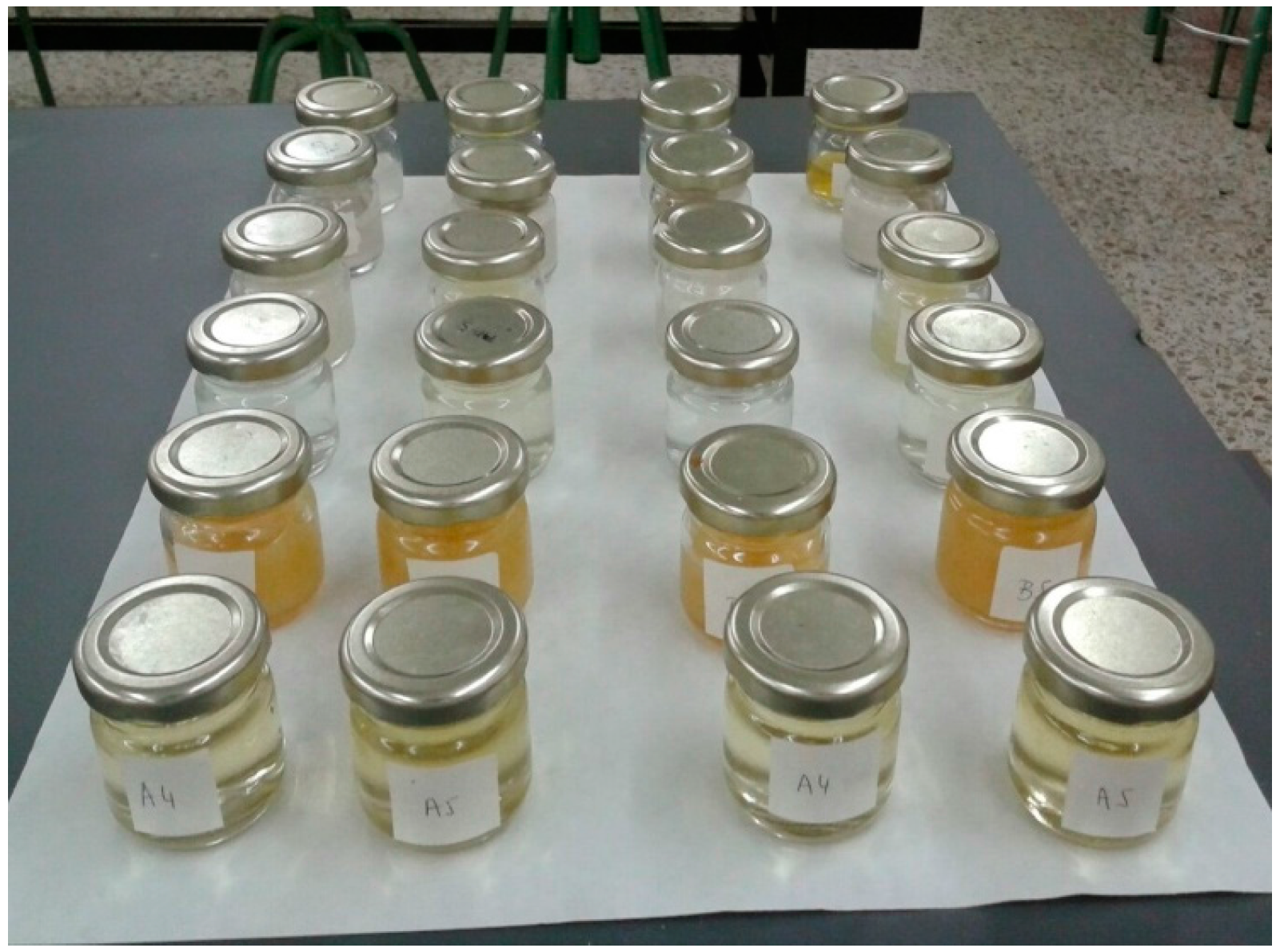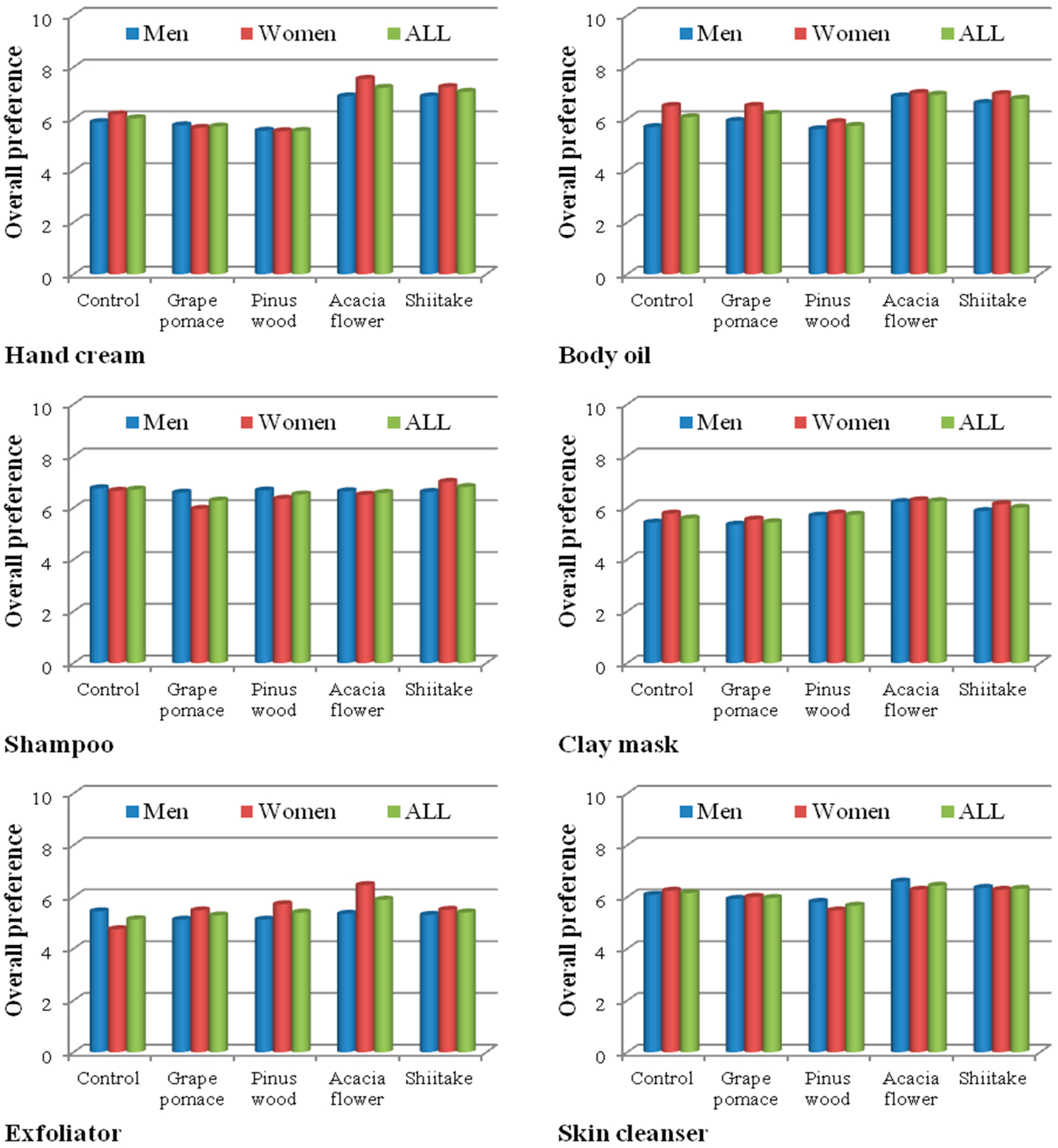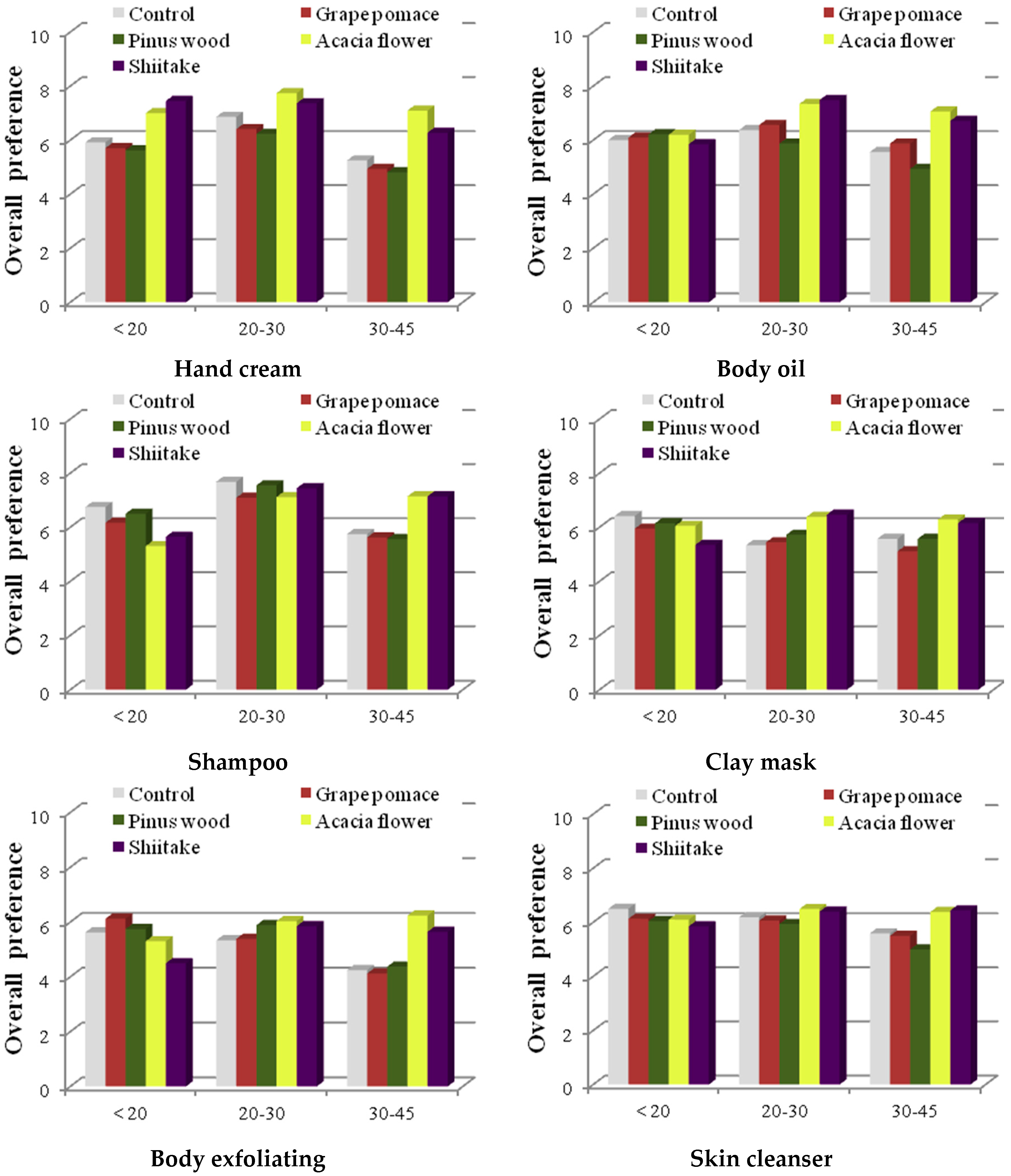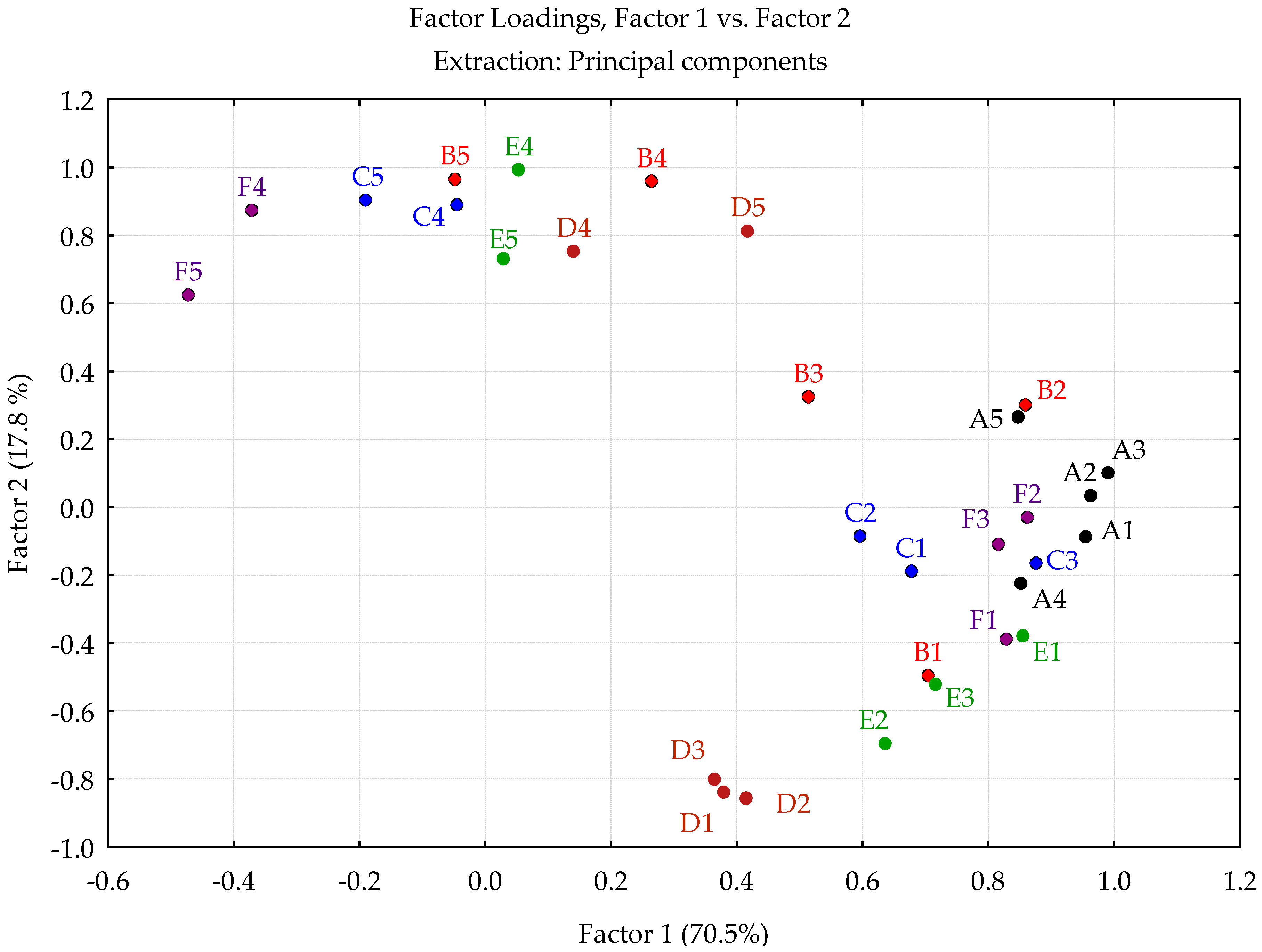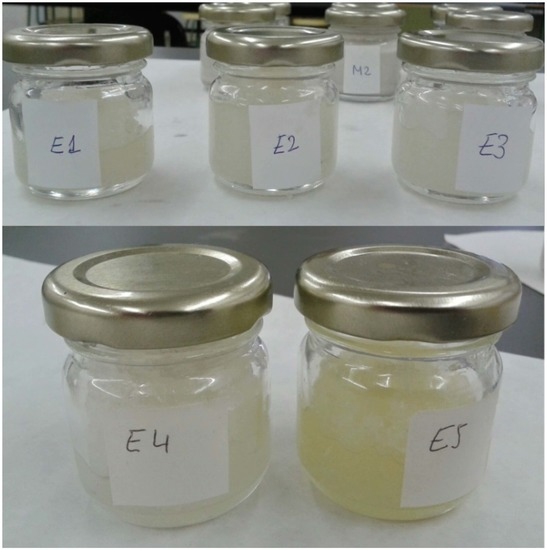1. Introduction
Consumers are increasingly demanding natural ingredients and additives in cosmetic products, as well as the replacement of synthetic compounds with possible negative effects on health and the environment [
1].
Antioxidants are preservatives with the function of preventing lipid oxidation of the product. They can act following different mechanisms, i.e., reducing agents, oxygen scavengers, synergistic agents, and chelating agents. More recently, antioxidant-based products have been proposed to protect the skin [
2,
3].
Among natural compounds with antioxidant properties, phenolics are the most studied. Natural phenolics—including benzoic acids, cinnamic acids, and flavonoids—are widely distributed in renewable and abundant sources, such as agricultural, food, and forest products and by-products. The utilization of these alternative low cost sources is desirable for the integral valorization of vegetal raw materials and could benefit the economy of the process and the cost of the products. The potential of selected natural extracts obtained from underutilized and residual vegetal biomass processed with food-grade green solvents as additives in cosmetic products was previously reported. The extracts were safe for topical use and enhanced the oxidative stability of model oil-in-water emulsions [
4].
Phenolic compounds present a wide variety of activities of interest in cosmetics, such as antioxidant, antimicrobial, anti-inflammatory, or anti-aging. Formulations enriched in phenolic antioxidants are increasingly used in anti-aging cosmetics as a defense strategy against reactive oxygen species (ROS) [
5]. In addition, natural phenolic compounds can permeate through the skin barrier, in particular the stratum corneum [
6].
Cosmetic products need to be effective and stable [
7], but also the acceptance by the consumer needs to be confirmed. Equally important are the favorable benefits on skin health and the desirable sensory attributes [
8], because the incorporation of natural extracts could confer undesirable characteristics and strong colors or aromas, that would limit the acceptance of the product.
Sensory analysis can discriminate the characteristics influencing consumer acceptance and to indicate how they are perceived and, consequently, guide success in the development of new cosmetic products. According to Elezoviü et al. [
9], the characteristics influencing consumer acceptance are based, first, on its packaging, and then on its smell, appearance, and texture (touch and feel). Therefore, after the development of a formulation, researchers and cosmetic companies should carry out a sensory evaluation with trained or consumer panels. Sensory analysis represents a valuable tool, but it is financially expensive and time-consuming. For this reason, some papers have recently appeared studying the application of instrumental analysis, mainly through rheological measurements, to detect changes of entry ingredients [
10,
11]. Cosmetic properties, such as the optimal mechanical properties (firmness), adequate rheological behavior, and appropriate adhesion, could be measured by instrumental analysis. Other attributes—including, appearance, odor, residual greasiness after application, or the sensation produced by the cosmetic application—play an important role in the acceptability of cosmetic products by consumers. They are subjective and, consequently sensory evaluation methods should be applied [
12,
13].
The objective of this work was to formulate six cosmetic products with ethanolic extracts from four vegetal raw materials which provide different types of aromatic families: flower, fruity, wood, and mushroom/earthy. The reducing power and radical scavenging capacity of the extracts were characterized and the sensory evaluation of the final personal-care products was assessed.
2. Materials and methods
2.1. Materials
Grape pomace was provided by Destilería Galicia (O Barco de Valdeorras, Ourense, Spain). Pine (Pinus pinaster) wood chips, kindly provided by FINSA Orember (Ourense, Spain), were air dried and milled under 1 mm. Acacia dealbata flowers were collected in forest areas in the surrounding of Ourense (Spain) in Winter 2014 and freshly processed. Shiitake (Lentinus edodes) was purchased in local markets and was freeze dried and ground before processing.
2.2. Extracts
Pressed distilled grape pomace was extracted with water at a liquid to solid ratio 15
w/
w, at 50 °C in an orbital shaker at 175 rpm overnight. The solid and liquid phases were separated by filtration and the liquid phase was contacted with non-ionic polymeric resins (Sepabeads SP700, Resindion S.R.L., Mitsubishi Chemical Corp., Milan, Italy). Before use, resins were rinsed with deionized water at a liquid-to-solid ratio of 5 (
w/
w). Desorption was carried out with 96% ethanol at a solvent to resin ratio 3 (mL/g) in an orbital shaker at 175 rpm and 50 °C. The resin was regenerated in 1 M NaOH overnight and further washed with deionized water [
14].
Ground Pinus pinaster wood samples, Acacia dealbata flowers, and ground freeze-dried Lentinus edodes samples were contacted with 96% ethanol in sealed Erlenmeyer flasks at 50 °C in an orbital shaker at 175 rpm overnight.
2.3. Cosmetic Formulations
Six cosmetic model products were formulated with conventional ingredients and with the extracts from the selected sources. The cosmetics prepared were: hand cream (HC), body oil (BO), shampoo (S), clay mask (CM), body exfoliating (BE), and a skin cleanser (SC). The ethanolic extracts—grape pomace extract (GPE), pine wood extract (PWE), acacia flowers extract (AFE), and shiitake extract (SE)—were added to cosmetics dissolved in a minimum amount of ethanol. These extracts have both the function of antioxidants and additives (colorants and perfumes). Control samples without extracts were also prepared.
Hand cream (HC) contained: paraffinun liquidum (30 g), lanolin (30 g), Kathon CG (0.2 g), and extract (five drops). Paraffin was slowly melted in a water bath (50 °C) and stirred to obtain an homogeneous mixture, which was neutralized with triethanolamine (if required). The extracts were added to the cold mixture.
Body oil (BO) was prepared with: almond oil (20 mL), Glycine soya oil (20 mL), Ricinus communis oil (10 mL). The oils were mixed with gentle stirring in a water bath at 40 °C, and once cooled, the extract was added.
Shampoo (S) was prepared with the following ingredients: sodium laureth sulfate (45 wt %), diethanolamine (3 wt %), Kathon CG (0.02 wt %), citric acid (0.01 wt %), extract (five drops) and distilled water. Approximately half of the water volume was mixed with the detergent and the other half was used to dissolve diethanolamine, citric acid and Kathon. Both solutions were mixed with intense stirring before adding the extract.
Clay mask (CM) was formulated with the following components: sodium laureth sulfate (0.1 g), kaolin (35 g), bentonite (5 g), cetyl alcohol (2 g), glycerin (10 g), Kathon CG (0.2 g), extract (five drops), and distilled water. Water was incorporated to bentonite and was allowed to stand 24 h until gelification. Cetyl alcohol was melted in a water bath. The detergent, glycerin, and the antimicrobial agent were added to the bentonite mixture, which was then heated at 40 °C. Kaolin was also added at this temperature, stirring to avoid lumps. The extract was added to the cooled mixture.
Body exfoliating salt scrub (BE) was composed of: sodium chloride (150 g), almond oil and extract (five drops). The oil was used in an amount needed to moist the salt, then the extract was added and the mixture was stirred until homogenization.
Skin cleanser (SC) was prepared with: cetyl alcohol (10.5 mL), liquid paraffin (30 mL), distilled water (258 mL), triethanolamine (1.5 mL), Kathon CG (0.6 mL), and extract (five drops). Cetyl alcohol was melted in a water bath at 70 °C and mixed with paraffin under mild stirring. Triethanolamine, the antimicrobial agent, and distilled water were mixed with continuous stirring at the previously indicated temperature. The aqueous phase was dropped on the oily phase until it coole and then the extract was added.
All cosmetic ingredients were purchased from Guinama (Valencia, Spain).
2.4. Analytical Methods
The extracts were characterized for phenolic and sugar content and for antioxidant activity. The personal care products were characterized for sensorial properties. Total phenolic content was colorimetrically determined using the Folin–Ciocalteu reagent (Sigma-Aldrich, St. Louis, MO, USA) and expressed as gallic acid (Sigma-Aldrich, St. Louis, MO, USA) equivalents. All analyses were performed at least in triplicate and are reported on a dry matter basis. Ash content was gravimetrically determined.
The monomeric sugars: glucose, xylose, mannose, and galactose, estimated from the concentrations of monosaccharides in samples previously hydrolyzed with 4% sulfuric acid at 121 °C for 20 min, were assayed by HPLC in a 1100 series Hewlett-Packard chromatograph fitted with a refractive index RI detector and a 300 × 7.8 mm Aminex HPX-87H column (BioRad, Hercules, CA, USA) operating at 60 °C (mobile phase: 0.003 M H
2SO
4, flow rate: 0.6 mL/min) [
15].
2.5. Antioxidant Activity
Ferric reducing antioxidant power (FRAP): The reagent, also used as blank, was prepared with 25 mL of 300 mmol/L acetate buffer (pH 3.6), 2.5 mL of a 10 mmol/L 2,4,6-tripyridyl-s-triazine (TPTZ) solution in 40 mmol/L HCl and 20 mmol/L FeCl3·6H2O in distilled water. Samples (100 μL) were mixed with 3 mL reagent, and the absorbance was monitored at 593 nm and compared with standard aqueous solutions of ascorbic acid.
ABTS (ABTS•+, 2,2′-azinobis (3-ethyl-benzothiazoline-6-sulfonate)): ABTS was produced by reacting 7 mM ABTS stock solution with 2.45 mM potassium persulfate. The ABTS•+ solution was diluted with PBS (pH = 7.4) to an absorbance of 0.70 at 734 nm and equilibrated at 30 °C. After addition of 1.0 mL of diluted ABTS•+ solution to 10 μL of extract or Trolox in ethanol or PBS the absorbance was read at 734 nm and 30 °C. The percentage was calculated as a function of the concentration of extracts and Trolox, and expressed as TEAC (Trolox equivalent antioxidant capacity).
2.6. Sensory Analysis
The sensory panel consisted of 26 female and 29 male assessors (18–45 years old) recruited from a pool of students and staff of IES Lauro Olmo (O Barco de Valdeorras, Ourense, Spain), without previous experience in sensory analysis. The six cosmetic samples (about 10 mL) were served in transparent glass containers encoded with three-digit random numbers. Mineral water and paper towels were provided for skin rinsing between samples.
Panelists were asked to fill out a questionnaire evaluating the intensity of the sensory properties by using a 0 to 10 scale (where 0 represents ‘none’ and 10 ‘extremely strong’) in two sessions along one month. The list contained 15 descriptors or attributes typically used to characterize the skincare products: six appearance attributes (gloss, color, odor intensity, odor preference, firmness/consistency, creaminess/texture/appearance) and eight skin parameters (spreadability, penetration, softness, skin odor intensity, skin odor preference, skin odor persistence, skin gloss, and skin feel). Finally, participants were asked to rate their global appreciation of the product on a 10-point scale to report which extract they preferred in each formulation. Assessors valuated the appearance attributes during the first session; the skin parameters and the comparison of the six personal-care products to the global score were recorded in the second session.
2.7. Statistical Analysis
Intensity values from sensorial data were analyzed by a two-factor (extract, cosmetic) analysis of variance (ANOVA) test using Excel software. A Fisher LSD post hoc test (p < 0.05) was used to test the significance of the relative mean differences among the samples. Differences among extracts and sample formulations were obtained from preference and descriptive data evaluated by means of principal component analysis (PCA) using the program Statistica 8.0 (Statsoft Inc., 2004, Tulsa, OK, USA).
3. Results and Discussion
3.1. Antioxidant Properties
The chemical, physical, and antioxidant properties of the selected extracts are shown in
Table 1. The extraction yields were 3.1 g extract/100 g grape pomace, 2.8 g extract/100 g pine wood, 16.9 g extract/100 g acacia flower, and 12.8 g extract/100 g shiitake. The extraction yield attained with the different sources was low, under 20% of the initial material. Therefore, the utilization of the solid for energy or bioconversion purposes could be proposed for further valorization.
The phenolic content in the extracts was higher for the grape pomace and acacia flower (18 wt %), and very low for the mushroom, which contained sugars and polyols (threalose, mannitol, and arabitol). The increased phenolic content of the extracts led to increased ABTS radical scavenging capacity and reducing capacity, except for the grape pomace extract. The most active radical scavengers were the acacia flower extract (AFE), followed by the grape pomace extract (GPE) and the pine wood extract (PWE), with 50–70% of the activity of Trolox. The highest reducing power was also found for AFE.
3.2. Sensorial Evaluation
Many natural products, botanicals, or waste materials—derived from agricultural products, foods and beverages—can be used in cosmetics products [
16]. Sensory test was carried out to evaluate the possibility of using natural extracts as ingredients of some cosmetic preparations and their acceptability by consumers. Independently of the antioxidant activity, the ethanolic extracts were added to provide their odoriferous characteristics to the different cosmetic formulations and to evaluate their acceptance by the consumers. Likewise, the color differed with raw material too and the volunteers scored also this difference. Personal-care products from acacia flowers extract (AFE) always showed an intense yellow color (
Figure 1).
Sensory analysis was performed to determine the preference for the natural extracts, because the composition of the individual formulations was the same, except in this ingredient. A control sample which did not contain any extract from the studied vegetal raw materials was used for reference. The most preferred and valued attributes in all cosmetics were spreadability, softness, consistence/texture, and skin feel, but the ANOVA results showed that these attributes in each cosmetic product were comparable and the use of the different extracts caused only a significant effect (p < 0.05) on two parameters: color and odor.
Participants from the two genres accomplished the sensory analysis (26 women and 29 men), and, as can be seen in
Figure 2, no great differences between them were found. Only four samples demonstrated significant differences: women evaluated better than men the acacia flower extract when it was included in the hand cream and exfoliating preparations, and the control-exfoliating and the shampoo with grape pomace extract obtained better scores with men than with women. Female participants valued body oil and clay masks better than males, and, on the contrary, men valued the shampoo more. Hand cream elaborated with acacia flowers or shiitake attained the best scores, with 7.20 and 7.04 points, respectively.
From the four assayed raw materials, the least preferred extracts in all cosmetics were red grape pomace and pinus wood ethanolic extracts. The average overall preference showed that these extracts were best valued as aromatic additives in the shampoo, and the worst score was attained by the exfoliating body. The cosmetic most valued with the acacia or shiitake extracts were the hand creams, and the worst was the body exfoliating cream. Control samples (without any added extracts) achieved similar scores than when GPE and PWE were added into all personal-care products, except in shampoo, where it was obtained the best punctuation along with the shiitake extract.
The participants were also divided into three age-segments: <20, 20–30, and 30–45 years, with 20, 19, and 16 persons, respectively. This last group perceived acacia and shiitake extracts with the significant highest values for all formulations, revealing the influence of color and odor of these natural extracts (
Figure 3). In opposition, the participants under 20 years of age preferred the extracts obtained from pinus wood and grape pomace or the control sample (without any extract), except in hand cream. These two extracts received lower score in the group of older participants. Consumers in the 20–30 years old segment evaluated samples with the highest overall preference values in all personal-care products, and the preferred extracts were acacia flowers and shiitake extracts.
The sensory characterization confirms which properties mostly influence consumer acceptance. All volunteers considered that the different tested personal-care products have a good spreadability, softness, and good skin penetration ability and posterior skin feeling; but also a pleasant color and fragrance. These results have shown that a variety of plant materials can be used as additives in cosmetic products to supply color and aroma [
17,
18,
19].
Principal component analysis (
Figure 4) was performed to know how consumer acceptance is based on sensory attributes. The interrelationships among the extracts from natural raw materials used in personal care-products and sensory descriptors showed that the first two factors explained 88.3% of the total variance among the extracts. The first component accounted for 70.5% of the data variability and the second for 17.8%. In the PCA the extract samples are clearly grouped into two clusters. Cluster 1, located in the upper half, was associated with the cosmetics elaborated from acacia flowers and shiitake extracts, which had the greatest acceptance. Cluster 2, in the positive part of Factor 1 and in the negative part of Factor 2, was characterized by the other two extracts (grape pomace and pine wood) and the control (without added extract). No differences between different cosmetic formulations were found.
All products were well-tolerated because any visible skin irritation or erythema was observed. Besides expected appearance, spreadability, softness, and skin feeling, the color and odor also play an important role on overall preference and, consequently, on purchase intent. According to the obtained results, fragrance and color were two important attributes for consumer preference and they are essential additives to make personal-care products, even, cosmetic companies use colors in packaging design to communicate the properties of their fragrances [
20]. Between the four assayed vegetal extracts, the floral aroma and yellow color provided by the acacia flower extract were evaluated higher by all consumers, independently of genre or age; likewise, this ethanolic extract also presented the highest in vitro antioxidant activity.
